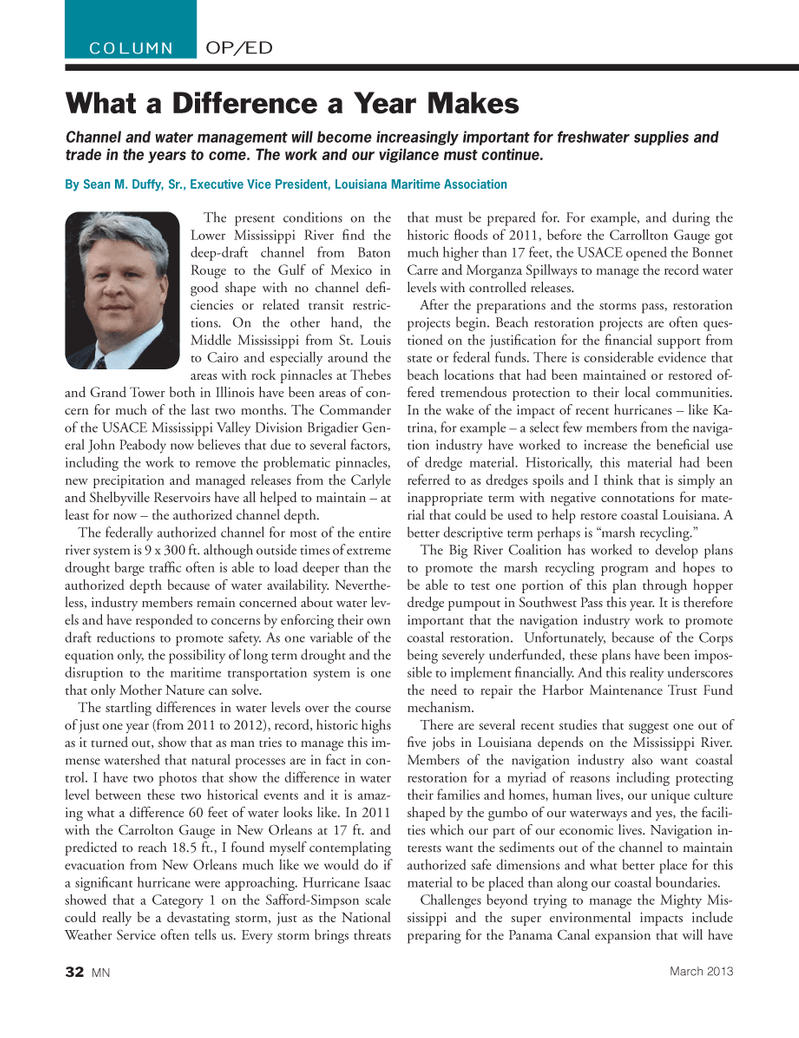
Page 32: of Marine News Magazine (March 2013)
Shipyard Report: Construction & Repair
Read this page in Pdf, Flash or Html5 edition of March 2013 Marine News Magazine
The present conditions on the Lower Mississippi River Þ nd the deep-draft channel from Baton Rouge to the Gulf of Mexico in good shape with no channel deÞ -ciencies or related transit restric- tions. On the other hand, the Middle Mississippi from St. Louis to Cairo and especially around the areas with rock pinnacles at Thebes and Grand Tower both in Illinois have been areas of con- cern for much of the last two months. The Commander of the USACE Mississippi Valley Division Brigadier Gen- eral John Peabody now believes that due to several factors, including the work to remove the problematic pinnacles, new precipitation and managed releases from the Carlyle and Shelbyville Reservoirs have all helped to maintain Ð at least for now Ð the authorized channel depth. The federally authorized channel for most of the entire river system is 9 x 300 ft. although outside times of extreme drought barge trafÞ c often is able to load deeper than the authorized depth because of water availability. Neverthe- less, industry members remain concerned about water lev- els and have responded to concerns by enforcing their own draft reductions to promote safety. As one variable of the equation only, the possibility of long term drought and the disruption to the maritime transportation system is one that only Mother Nature can solve. The startling differences in water levels over the course of just one year (from 2011 to 2012), record, historic highs as it turned out, show that as man tries to manage this im- mense watershed that natural processes are in fact in con- trol. I have two photos that show the difference in water level between these two historical events and it is amaz- ing what a difference 60 feet of water looks like. In 2011 with the Carrolton Gauge in New Orleans at 17 ft. and predicted to reach 18.5 ft., I found myself contemplating evacuation from New Orleans much like we would do if a signiÞ cant hurricane were approaching. Hurricane Isaac showed that a Category 1 on the Safford-Simpson scale could really be a devastating storm, just as the National Weather Service often tells us. Every storm brings threats that must be prepared for. For example, and during the historic ß oods of 2011, before the Carrollton Gauge got much higher than 17 feet, the USACE opened the Bonnet Carre and Morganza Spillways to manage the record water levels with controlled releases. After the preparations and the storms pass, restoration projects begin. Beach restoration projects are often ques- tioned on the justiÞ cation for the Þ nancial support from state or federal funds. There is considerable evidence that beach locations that had been maintained or restored of- fered tremendous protection to their local communities. In the wake of the impact of recent hurricanes Ð like Ka- trina, for example Ð a select few members from the naviga- tion industry have worked to increase the beneÞ cial use of dredge material. Historically, this material had been referred to as dredges spoils and I think that is simply an inappropriate term with negative connotations for mate- rial that could be used to help restore coastal Louisiana. A better descriptive term perhaps is Òmarsh recycling.Ó The Big River Coalition has worked to develop plans to promote the marsh recycling program and hopes to be able to test one portion of this plan through hopper dredge pumpout in Southwest Pass this year. It is therefore important that the navigation industry work to promote coastal restoration. Unfortunately, because of the Corps being severely underfunded, these plans have been impos- sible to implement Þ nancially. And this reality underscores the need to repair the Harbor Maintenance Trust Fund mechanism.There are several recent studies that suggest one out of Þ ve jobs in Louisiana depends on the Mississippi River. Members of the navigation industry also want coastal restoration for a myriad of reasons including protecting their families and homes, human lives, our unique culture shaped by the gumbo of our waterways and yes, the facili- ties which our part of our economic lives. Navigation in- terests want the sediments out of the channel to maintain authorized safe dimensions and what better place for this material to be placed than along our coastal boundaries. Challenges beyond trying to manage the Mighty Mis- sissippi and the super environmental impacts include preparing for the Panama Canal expansion that will have OP/EDCOLUMNWhat a Difference a Year Makes Channel and water management will become increasingly important for freshwater supplies and trade in the years to come. The work and our vigilance must continue. By Sean M. Duffy, Sr., Executive Vice President, Louisiana Maritime Association March 2013 32 MNMN March2013 Layout 32-49.indd 32MN March2013 Layout 32-49.indd 323/4/2013 3:16:09 PM3/4/2013 3:16:09 PM

 31
31

 33
33
